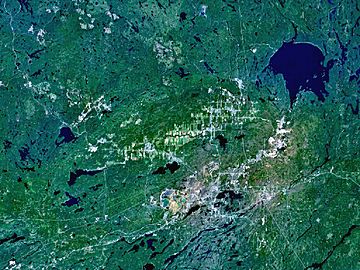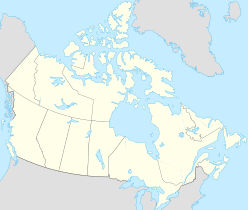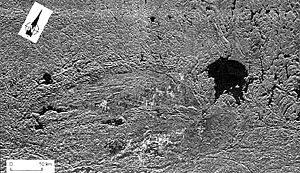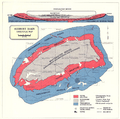Sudbury Basin facts for kids
| Sudbury Structure | |

NASA World Wind satellite image of the Sudbury astrobleme
|
|
| Impact crater/structure | |
|---|---|
| Confidence | Confirmed |
| Diameter | 130 km (81 mi) |
| Age | 1849 Ma Paleoproterozoic |
| Exposed | Yes |
| Drilled | Yes |
| Location | |
| Coordinates | 46°36′N 81°11′W / 46.600°N 81.183°W |
| Country | Canada |
| Province | Ontario |
The Sudbury Basin is a huge bowl-shaped area in Ontario, Canada. It's one of the biggest and oldest impact craters on Earth.
You can find the basin in the city of Greater Sudbury, Ontario, on a very old part of the land called the Canadian Shield. People who live there often call it "The Valley." The main part of Sudbury city is just outside the southern edge of the basin.
There are other interesting rock formations nearby. However, they were not made by the same event that created the Sudbury Basin.
How the Sudbury Basin Formed
The Sudbury Basin was created when a giant space rock, called a bolide, crashed into Earth. This bolide was about 10 to 15 kilometers (6 to 9 miles) wide. The huge impact happened 1.849 billion years ago, during a time called the Palaeoproterozoic era.
The crash threw rocks and dust over a massive area. Debris from the impact spread across 1.6 million square kilometers (620,000 square miles). Some rock pieces traveled over 800 kilometers (500 miles) away, reaching as far as Minnesota.
Such a large impact likely scattered debris all over the world. However, most of it has worn away over billions of years. Scientists believe the original crater was a round shape about 250 kilometers (155 miles) wide.
Over time, Earth's geological processes changed the crater's shape. It became the smaller, oval shape we see today. This makes the Sudbury Basin the second-largest crater on Earth. The largest is the 300-kilometer (186-mile) Vredefort crater in South Africa. The Sudbury Basin is larger than the 170-kilometer (105-mile) Chicxulub crater in Yucatán, Mexico.
Size and Shape of the Basin
The Sudbury Basin is currently 62 kilometers (38 miles) long and 30 kilometers (19 miles) wide. It is also about 15 kilometers (9 miles) deep, though the ground surface today is much shallower.
Images for kids
-
Shatter cone from Sudbury Impact Structure, found in Cleveland Museum of Natural History
-
Rich ore sample from Sudbury, collected in 1932: Pentlandite - Chalcopyrite - Pyrrhotite
See also
 In Spanish: Cuenca de Sudbury para niños
In Spanish: Cuenca de Sudbury para niños






